by Albert D. Kollar and Mary Wilcop
On a sunny fall weekend last November 6th and 7th, a celebration honored the 125th Anniversary (1895 – 2020) of the founding of the Carnegie Library of Pittsburgh (1895) and the Carnegie Institute Extension, now Carnegie Museums of Pittsburgh, by philanthropist Andrew Carnegie (1835 – 1919)1 (fig. 1).
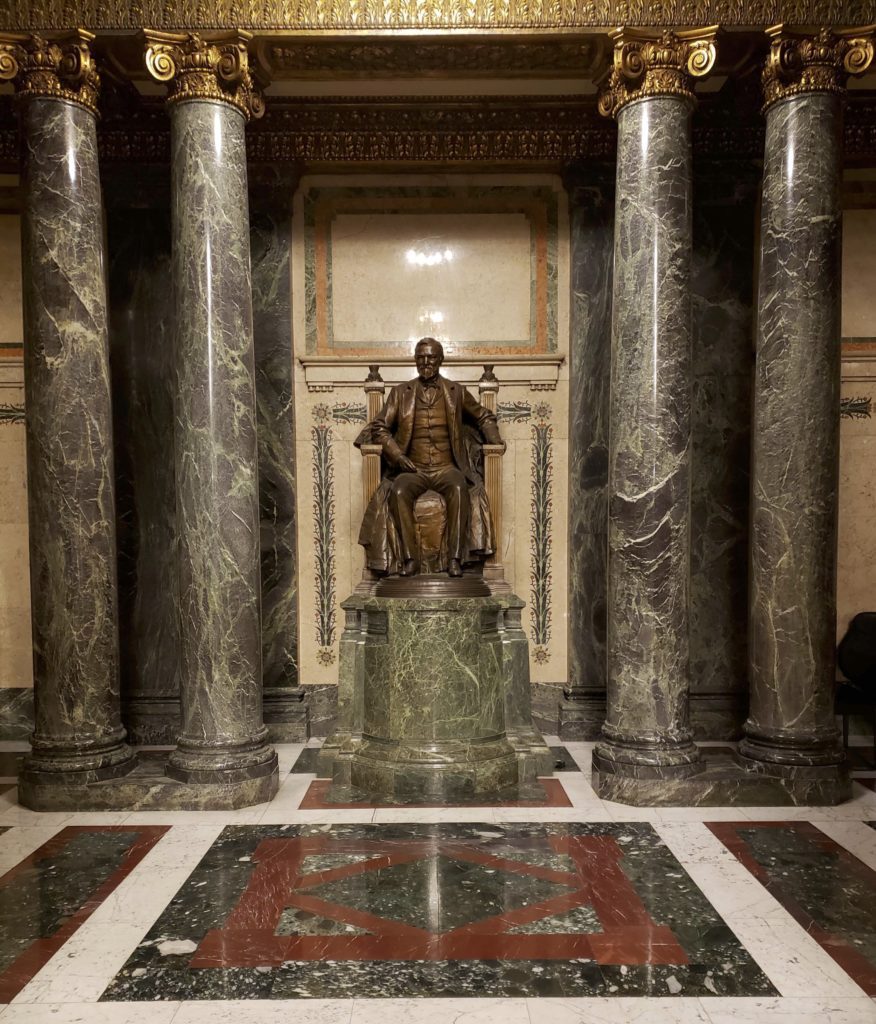
Although the event had been postponed for a year due to the COVID-19 pandemic, the 2021 “Crash the Carnegies” celebration was enjoyed by thousands of visitors. Inside the Oakland museums, families enjoyed artmaking, performance, and learning activities that paid homage to Carnegie Museums’ past 126 years. Fronting Forbes Avenue, the statues and art works that lend much to the understanding of all that’s presented inside, continued their silent vigil.
The Buildings
The long stretch of buildings along Forbes Avenue in the Oakland neighborhood of Pittsburgh is home to Carnegie Museum of Art, Carnegie Museum of Natural History, and Carnegie Music Hall. The entrance to the Carnegie Library of Pittsburgh, the furthest west section of the massive complex, faces the gateway to Schenley Park. The connected buildings that comprise this modern campus were constructed in three distinct phases (the first building in 1895, an extension in 1907, and the new Scaife wing in 1974)². A review of the history of the Carnegie Library and Institute buildings’ is available in the posts “CMP Travel Program and Section of Invertebrate Paleontology Promote the 125th Anniversary of the Carnegie Library of Pittsburgh With a Walking Tour” and “A Journey to France to Uncover the Mysteries of the Carnegie’s Grand Staircase.”

With 1895-era facades made of elegant light gray Berea sandstone mined from a quarry in Amherst, Ohio 2, the Carnegie Library and Institute building proclaimed itself to Pittsburgh and the world at large as, in Andrew Carnegie’s own words, a “palace of culture.”3 The library was built, both financially and literally, by Carnegie Steel. Earlier, the company’s structural metal beams were used in Pittsburgh’s first skyscraper, the Carnegie Steel Building, a structure designed by Longfellow, Alden, and Harlow (Floyd 1993)5. The Carnegie Institute Extension (1907), undergirded by a steel support frame, used steel beams fabricated at the newly created United States Steel Corporation Homestead Works, formerly Carnegie Steel1 (fig 2).
John Massey Rhind Bronze Statues
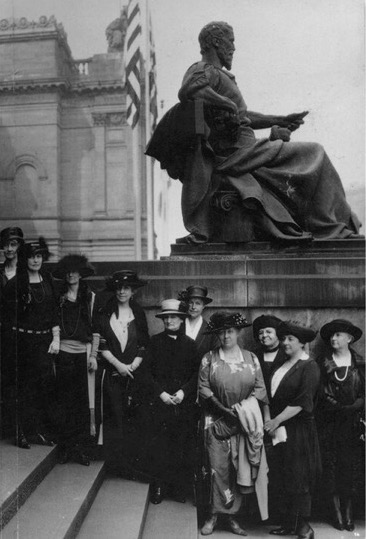
With the completion of the Beaux-Arts style Carnegie Institute Extension, departments of music, art, literature, and science were established as distinct administrative divisions of Carnegie Institute and Library. These now lapsed distinctions are mirrored on the building’s exterior in the bronze sculptures collectively referred to as the Noble Quartet. Seated in classical Greek chairs made of Barre Granodiorite of Vermont2 are four male figures. The statues of Shakespeare (literature) and Bach (music) sit atop granodiorite slabs on either side of the main granodiorite staircase to the Music Hall entrance. Just east of them, at the entrance to the art and natural history museums, are seated Michelangelo representing art (fig. 3) and Galileo representing science.
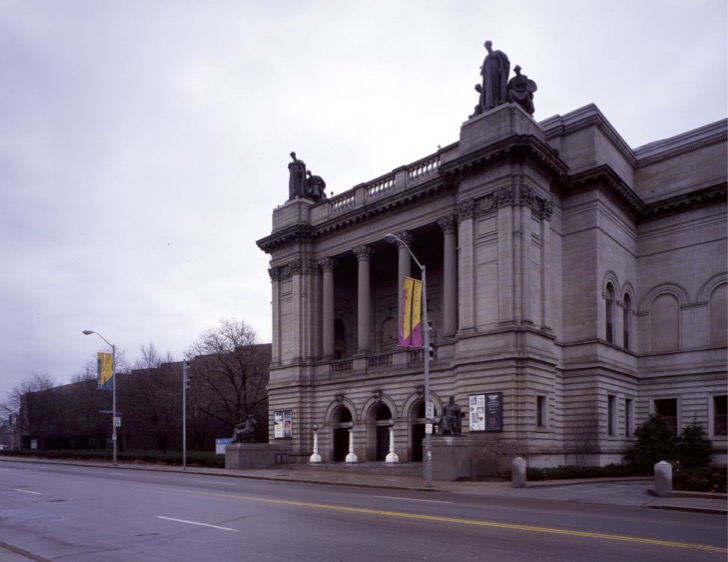
John Massey Rhind (1858 – 1936), a close friend of Andrew Carnegie, was commissioned by him to create these works along with four others that tower three stories above them from parapets on the edge of the building’s roof (fig. 4). Known as the Muses, these standing female figures represent allegorical spirits whose achievements equal those of their seated counterparts. The creation of eight largescale architectural figures to match the Classical style of the building was not an easy task. Statue models shaped in clay by the artist, were shipped from his New York studio to Italy to be cast in the lost-wax process, then returned for assembly and finishing6.
Sarah Scaife Gallery
In 1974, the footprint of the Oakland campus expanded once more with the opening of the Sarah Scaife Gallery. Designed by renowned New York City architect Edward Larrabee Barnes (1915-2004), with large spaces and high windows, the gallery exterior is in some ways a modern equivalent of the Beaux-Arts Carnegie Institute Extension3.
The new building was constructed in a more modernist style commensurate with the contemporary architectural styles at the time. Its interior is clad with Larvikite, a beautiful gray blue iridescent igneous rock from Larvik, Norway⁸. The exterior cladding is also Larvikite, but here the stone has a bronze iridescent color to create visual continuity between the radically different Beaux Art and modernist structures.
By 1974, after nearly a century of atmospheric soot and pollutants from the steel mills and other modes of industrial and residential coal use, the old light gray Berea sandstone of the 1907 building darkened to a deep brown. This intended cohesion no longer exists because the sandstone underwent a major cleaning in 19899. Its original pale tone now stands in contrast to the naturally bronze-toned Larvikite.
Richard Serra Carnegie Sculpture and COR-TEN Steel
In contrast to the bronze sculptures used in the 1907 Carnegie Extension, sculptures made of modern alloys of steel and aluminum are incorporated into the exterior plazas of the 1974 Sarah Scaife Gallery. The largest of these works is the Richard Serra Carnegie sculpture, which was installed as public art for the 1985 Carnegie International and was selected in a tie for that exhibition’s first prize10.
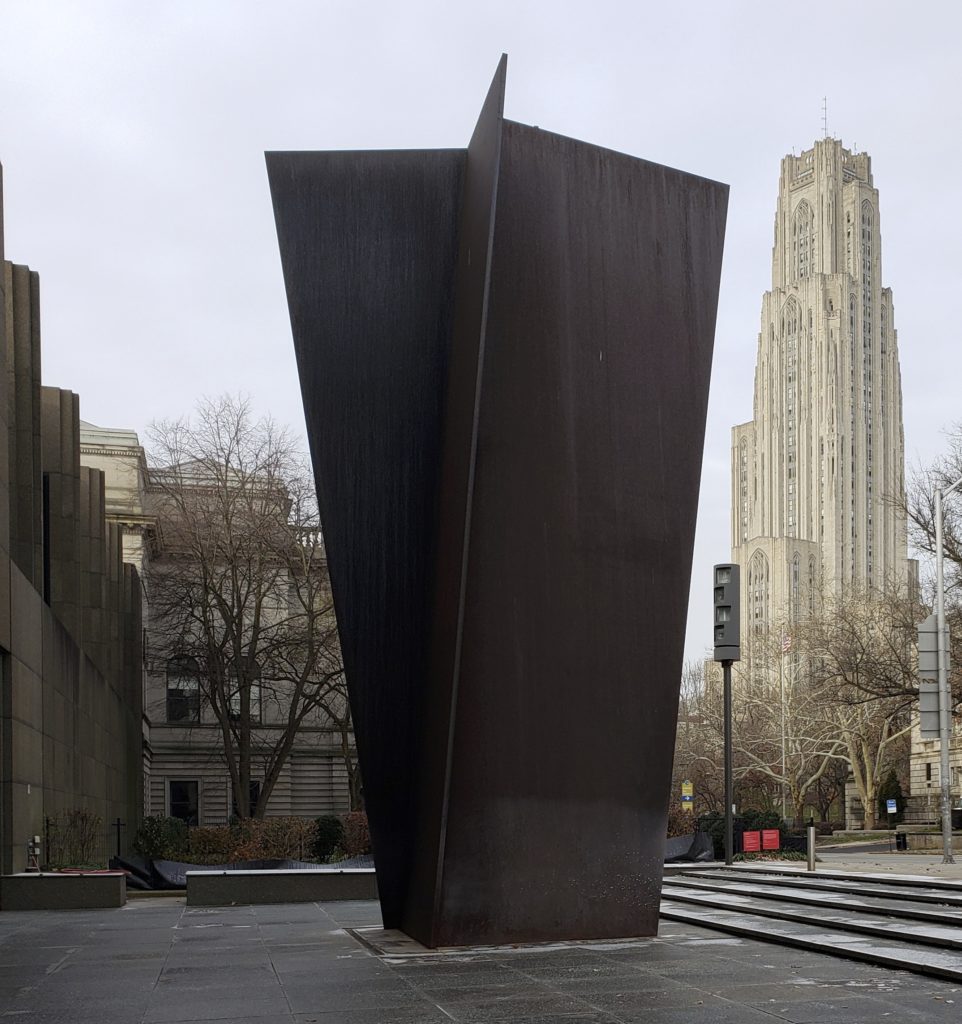
The 40-foot tower, made of four panels of 2.5-inch-thick COR-TEN steel with acute edges and corners, emerges from the Larvikite surface of the entrance plaza. The sculpture commands great sight lines with its height and profile echoing that of the nearby Cathedral of Learning, the University of Pittsburgh’s 42-story Gothic Revival, Art Deco tower (fig.5).
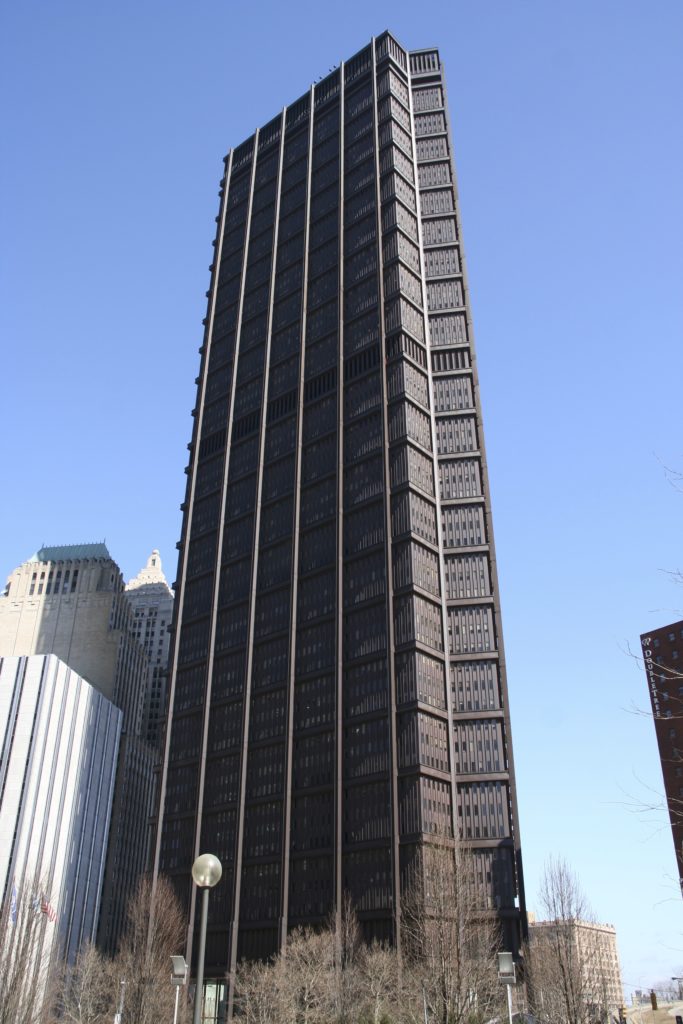
COR-TEN is a proprietary high-strength, low-carbon steel alloy introduced by U.S. Steel Corporation in 1933. It features prominently in the company’s Pittsburgh headquarters, the U.S. Steel Tower, built in 1971 (fig. 6)¹². The name COR-TEN is an amalgam that references the product’s most notable properties, corrosion resistance and high tensile strength. The steel’s exceptional resistance to atmospheric corrosion negates the need for painting. After production, in a process that occurs over several months, a surface patina develops as the steel is exposed to wet and dry weather cycles. In many applications COR-TEN surfaces turn a reddish orange, but colors can vary from orange to brown depending, in part, on atmospheric conditions. Very fine surface oxidation layers can also build to create a rainbow-like iridescence, known as structural color – the same process that lends colorful beauty to peacock feathers and butterfly wings.
By the mid-1960s, the unique properties of COR-TEN attracted the interest of artists, especially those producing outdoor sculptures. Beverly Pepper, a sculptor known for her large-scale metal works, was introduced to COR-TEN’s properties while working at the U.S. Steel factory in Conshohocken, Pennsylvania. In 1964 she was the first sculptor to explicitly use COR-TEN as a sculptural medium11. Other artists soon followed, including Serra in the early 1970s. Although Serra was originally trained as a painter, he was already familiar with the working properties of steel. The artist’s father worked in steel mills and as a pipefitter. Later, Serra supported some of his schooling by working in steel mills14.
By the time Serra’s design was conceived in 1985, only one company, the Lukens Steel Company, which operated the world’s widest rolling mill in the southeastern Pennsylvania town of Coatesville, could produce the large plates required for the commission. After production the plates were shipped across the state to a Pittsburgh-Des Moines Corporation plant on Neville Island, just outside Pittsburgh, for assembly.
The Significance of Carnegie
In its sheer size and monolithic simplicity, Carnegie lends itself to many interpretations. Like the large institution it fronts, the sculpture can be experienced from walking around the outside and by standing within.
By the time of Carnegie’s installation, leaning metal plates were a feature of several of Serra’s public sculptures. For Carnegie, however, the plates were made both to lean and tilt diagonally, rather than being strictly vertical, a form Serra describes as “almost like a V or like lifting your arms up.”6 Implicitly, though perhaps unintentionally, this form and its materiality may speak to the original vision Andrew Carnegie expressed in an 1897 letter: “….not only our own country, but the civilized world will take note of the fact that our Dear Old Smoky Pittsburgh, no longer content to be celebrated only as one of the chief manufacturing centers[sic], has entered upon the path to higher things, and is before long […] also to be noted for her preeminence in the Arts and Sciences”16.
Symbolism. Alone in Carnegie
The bare steel, deliberately lacking any interior or exterior covering, stands prominently in the plaza asserting its own essentialness to the story of the museum.
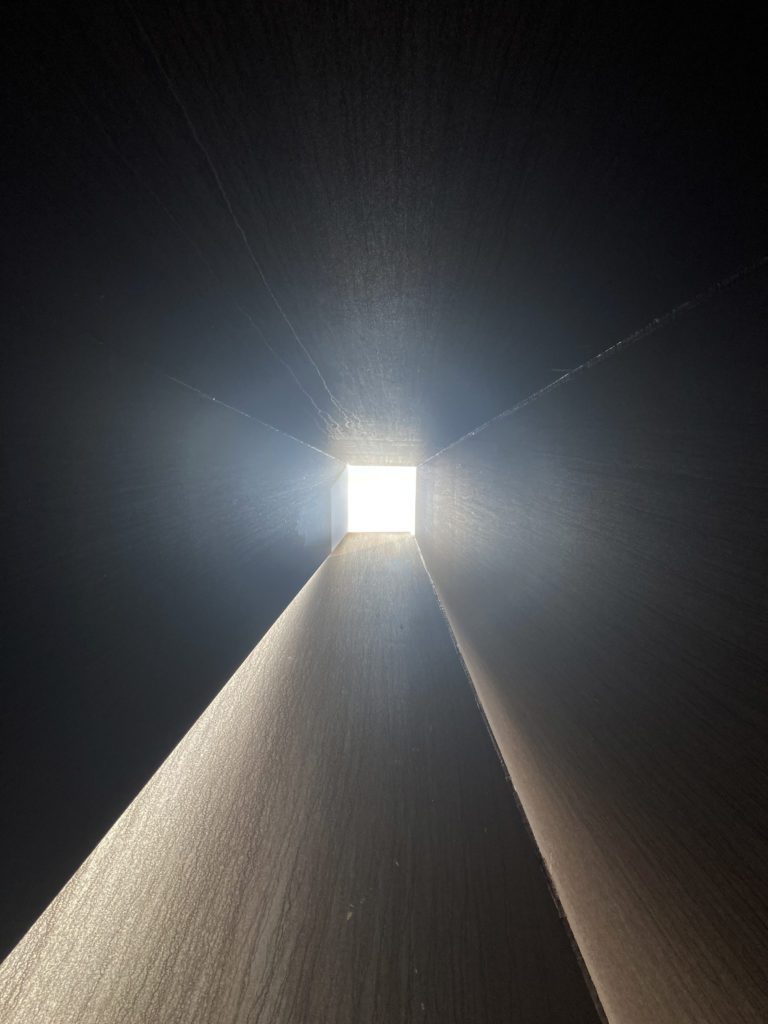
To enter the sculpture’s interior from its Forbes Avenue side, visitors slide through a tapered passage between two plates. Once inside, even on the brightest summer days, several minutes are needed to adjust one’s eyes to overwhelming darkness of the interior. Following the walls upwards leads to a glowing view of the sky, blue or gray, depending upon the weather, and undoubtedly occasionally rose pink for some moments at dawn and dusk. The effect is intentionally physically and visually destabilizing (fig 7).

Some visitors experience entering the tower-like structure as a representation of a steel mill’s blast furnace. In this sense, the design functions as an extension of the John White Alexander Crowning of Labor murals in the Grand Staircase, which depict workers making steel in the first floor murals and, as the smoke rises to the second floor, reveal female spirits bringing the fruits of labor to a knight in steel armor who resembles Andrew Carnegie17 (fig. 8).
Serra often hesitated to assign a single meaning to his sculptures, preferring their interpretation remain broad and therefore boundless. Still, in an interview with Art Historian Vicky Clark during the work’s installation, the artist struggled to completely separate the sculpture from its implicit connections to the museum and Pittsburgh. “There’s something about steelworkers and the tradition of steelworkers that means that they have a basic respect for how something is built. It becomes a metaphor for what the industry of the town has produced.” 6
Sculptures and Thought in the 21st Century
While John Massey Rhind’s Noble Quartet functions mainly as an embellishment to the building, with a specific interpretation dictated by Carnegie himself, the situating of Carnegie in the plaza speaks to the extent to which the function of art and architecture, near the end of the 20th century, had fundamentally changed. Rhind’s Quartet were positioned to sit along the sides of the Carnegie Institute’s original entryways, out of the path of visitors. Carnegie, in contrast, stands imposingly in front of the Scaife extension entrance, almost requiring entering patrons and passersby to engage with it.
Sculptures of the modern era, particularly those of architectural scale, create environments for individuals to think and reflect, without necessarily a prescribed end in mind. A viewer’s interaction with an artwork like Carnegie can feel obtuse; its faceless abstraction refuses to tell us what it is or how we should feel about it. This ambiguity, for Serra, however, is essential, because it means that “the piece has the potential to engage people with various meanings they might have.”6 Like the Quartet, Carnegie, speaks to the outside world about what we might find within. That is, that art, and the museum itself, serve as a site for contemplation and reflection—and not only about art.
Albert D. Kollar is the Collection Manager in the Section of Invertebrate Paleontology at Carnegie Museum of Natural History. Mary Wilcop is Associate Objects Conservator at Carnegie Museum of Art.
References
1Kollar, A.D. 2021. The Carnegie Library of Pittsburgh (1895) and Carnegie Institute Extension (1907): The Story of the Carnegie Building Stones and Architectural Design presented for the 125th “Crash the Carnegie” Celebration held in north wing of the Carnegie Library of Pittsburgh.
2Kollar, A.D., M. Feeley, A. Joyce Jr., R. Fedosick, K. Hughes, and A. Costanzo. 2020. Carnegie Institute Extension Connemara Marble: Cross-Atlantic Connections Between Western Ireland and Gilded Age Architecture in Pittsburgh, Pennsylvania. ACM, 86: 207-253.
3Gangewere, R. 2011. Palace of Culture Andrew Carnegie’s Museum and Library of Pittsburgh. University of Pittsburgh Press, 332p.
4Kollar, A.D. and B. Tucker. 2020. CMP Travel Program and Section of Invertebrate Paleontology promotes the 125th Anniversary of the Carnegie Library of Pittsburgh with an outdoor walking tour. https://carnegiemnh.org/125th-anniversary-carnegie-library-of-pittsburgh-outdoor-walking-tour/
5Floyd, M.H. 1994. Architecture After Richardson, Regionalism before Modernism – Longfellow, Alden, and Harlow in Boston and Pittsburgh. The University of Chicago Press, Chicago. 546 pp.
6 Clark, V. November 1985. “Richard Serra’s Carnegie, an unpublished interview.” http://vickyaclark.com/serra_interview.html
7Gangewere, R. 1992. What the Muses Hold. Carnegie Magazine, 13-17.
8Heldal, T., and G. B. Meyer & R. Dahl. 2015. Global stone heritage: Larvikite, Norway. 21-34. Geological Society, London, Special Publication, 407.
9Gangewere, R. 1990. Cleaning The Carnegie. Carnegie Magazine, 31 – 35.
10CARNEGIE Fall 2021. 125 Years: A History in Objects Continues.
11 Smithsonian Archives of American Art. July 1-2, 2009. Oral history interview with Beverly Pepper. Washington, DC: Smithsonian Institution. https://www.aaa.si.edu/download_pdf_transcript/ajax?record_id=edanmdm-AAADCD_oh_283468
12Jester 1995.
12USS Cor-Ten Steel. 1980. USS Cor-Ten High Strength Low-Alloy Steel.
13https://www.aaa.si.edu/download_pdf_transcript/ajax?record_id=edanmdm-AAADCD_oh_283468
14 https://news.artnet.com/art-world/beverly-pepper-marlborough-contemporary-1470469
15 Lidji, E. 1985. CARNEGIE, Richard Serra. Carnegie International Article.
16Wall, J. F. 1970. Andrew Carnegie. University of Pittsburgh Press. 1137p.
17Gangewere, R. personal communication.
Related Content
Understanding Fossil Fuels Through Carnegie Museums’ Exhibits
University of Michigan Helps Solve Century Old Fossil Mystery
A Century Ago, A Donor Walked Into the Carnegie Museum
Carnegie Museum of Natural History Blog Citation Information
Blog author: Kollar, Albert D.; Wilcop, MaryPublication date: March 24, 2022
